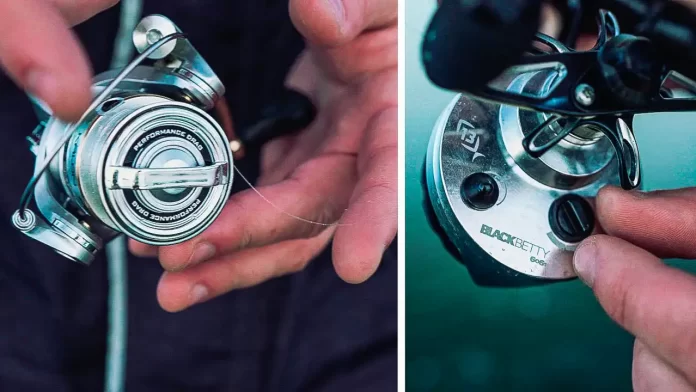Ice fishing lines can be notoriously tricky to handle, whether spooled on a conventional spinning reel or modern ice fishing inline reel. First, ice fishing reels are often smaller, which means line coils are tighter — tighter coils in conjunction with cold temperatures lead to line memory and a springiness that causes the line to jump off reels uncontrollably. Wired2fish’s McKeon Roberts shares four simple tips to tame and take control of your ice fishing lines, focusing on fluorocarbon and monofilament varieties. Following his guidance will result in less re-rigging downtime, better bait action (more bites!), and better bite detection.
FEATURED GEAR (retail links)
LINE
- FLUOROCARBON LINE – Sufix Invisiline Fluorocarbon Ice Line @ FishUSA
- MONOFILAMENT LINE – Sufix Ice Magic Monofilament @ FishUSA
- Ice Fishing Line @ FishUSA
REELS
- SPINNING REEL – 13 Fishing Kalon C 1.0 Spinning Reel @ 13Fishing.com
- INLINE REEL – 13 Fishing BlackBetty 6061 @ FishUSA
- INLINE REEL – 13 Fishing Black Betty Freefall Ghost Blackout Glow Inline Ice Reel @ FishUSA
- Ice Fishing Reels @ FishUSA
RODS
Roberts’ 4 tips for improved ice fishing line handling:
-
Adjust your spoon tension dial (inline reels)
Modern inline ice reels function like a casting reel in that backlashing can be a problem — it’s common for the line to discharge off the spool faster than your bait sinks. The problem is that line lodges between the spool and gearing, requiring you to remove the spoon to untangle it. Roberts combats this problem by immediately adjusting the reel tension dial to the weight of the lure. More tension slows the reel line discharge and is the easiest way to reduce “rats nests.” Aside from this, inline reels are a godsend in line twist reduction based on their straight, inline line retrieve and fall mechanics. Additionally, their bigger spool diameters create bigger line coils, resulting in less line memory than their spinning reel cousins.
-
Stripping your line (inline reels)
Stripping or hand-pulling your line is another option to get your bait to the bottom in a tangle-free manner. In this scenario, Roberts engages the inline free spool while palming the spool to prevent rotation. He then simultaneously pulls the line from the end of the rod while reducing pressure on the reel, effectively stripping the line off the reel without relying on free-spooling. The stripping method also has the benefit of stretching the line as it’s removed from the spool, eliminating memory and resulting in a straight and direct connection to the bait.
-
Stretching your line
Stretching your line removes memory and is easily achieved by keeping your reel engaged and using drag as resistance. Loosen your drag a bit and strip the line off the reel in increments, ensuring there’s enough drag tension to put a meaningful load against the line. The result is a memory-free section of line that reduces lure spin and line coiling, so you have a straight and direct connection between your lure and the end of the rod.
-
Controlled free-fall
A spinning reel presents the fastest way to get your bait to the bottom — this is accomplished by opening the bail and letting the line fly off unimpeded, with the lure free-falling under its weight. If your line has memory, it’ll often fly off too fast and snarl onto itself or around your rod guides and tip. Mitigate this by stretching your line, as explained above. Secondly, you can place a lead hand in contact with the line in front of the spool to moderate the flow off the reel. Doing so is an easy method to prevent the excess line from jumping off the spool and creating a mess.
OTHER GEAR
- FISH FINDER – Humminbird ICE HELIX 7 CHIRP GPS G4 @ Humminbird.com
- SAFETY PICKS – Rapala Ice Safety Picks @ FishUSA
- ICE BIBS – StrikeMaster Pro Bibs @ Rapala.com
- HOODY – 13 Fishing “Modern Tuxedo” Hooded Sweatshirt @ Tackle Warehouse
Check out our Ice Fishing Essential Gear Guide for knowledge on getting started in ice fishing!
Credit: Source link































